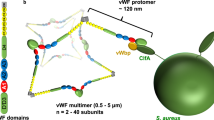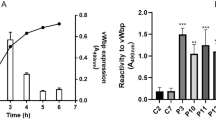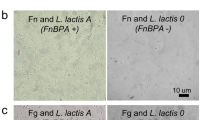Abstract
M1 protein, a major virulence factor of the leading invasive strain of group A Streptococcus, is sufficient to induce toxic-shock-like vascular leakage and tissue injury. These events are triggered by the formation of a complex between M1 and fibrinogen that, unlike M1 or fibrinogen alone, leads to neutrophil activation. Here we provide a structural explanation for the pathological properties of the complex formed between streptococcal M1 and human fibrinogen. A conformationally dynamic coiled-coil dimer of M1 was found to organize four fibrinogen molecules into a specific cross-like pattern. This pattern supported the construction of a supramolecular network that was required for neutrophil activation but was distinct from a fibrin clot. Disruption of this network into other supramolecular assemblies was not tolerated. These results have bearing on the pathophysiology of streptococcal toxic shock.
This is a preview of subscription content, access via your institution
Access options
Subscribe to this journal
Receive 51 print issues and online access
$199.00 per year
only $3.90 per issue
Buy this article
- Purchase on Springer Link
- Instant access to full article PDF
Prices may be subject to local taxes which are calculated during checkout





Similar content being viewed by others
References
Fischetti, V. A. Streptococcal M protein: molecular design and biological behavior. Clin. Microbiol. Rev. 2, 285–314 (1989)
Cunningham, M. W. Pathogenesis of group A streptococcal infections. Clin. Microbiol. Rev. 13, 470–511 (2000)
Facklam, R. F. et al. Extension of the Lancefield classification for group A streptococci by addition of 22 new M protein gene sequence types from clinical isolates: emm103 to emm124. Clin. Infect. Dis. 34, 28–38 (2002)
Steer, A. C., Law, I., Matatolu, L., Beall, B. W. & Carapetis, J. R. Global emm type distribution of group A streptococci: systematic review and implications for vaccine development. Lancet Infect. Dis. 9, 611–616 (2009)
Aziz, R. K. & Kotb, M. Rise and persistence of global M1T1 clone of Streptococcus pyogenes . Emerg. Infect. Dis. 14, 1511–1517 (2008)
Herwald, H. et al. M protein, a classical bacterial virulence determinant, forms complexes with fibrinogen that induce vascular leakage. Cell 116, 367–379 (2004)
Kahn, F. et al. Antibodies against a surface protein of Streptococcus pyogenes promote a pathological inflammatory response. PLoS Pathog. 4, e1000149 (2008)
McNamara, C. et al. Coiled-coil irregularities and instabilities in group A Streptococcus M1 are required for virulence. Science 319, 1405–1408 (2008)
Soehnlein, O. et al. Neutrophil degranulation mediates severe lung damage triggered by streptococcal M1 protein. Eur. Respir. J. 32, 405–412 (2008)
Gautam, N. et al. Heparin-binding protein (HBP/CAP37): a missing link in neutrophil-evoked alteration of vascular permeability. Nature Med. 7, 1123–1127 (2001)
Linder, A., Christensson, B., Herwald, H., Bjorck, L. & Akesson, P. Heparin-binding protein: an early marker of circulatory failure in sepsis. Clin. Infect. Dis. 49, 1044–1050 (2009)
Shannon, O. et al. Severe streptococcal infection is associated with M protein-induced platelet activation and thrombus formation. Mol. Microbiol. 65, 1147–1157 (2007)
Spraggon, G., Everse, S. J. & Doolittle, R. F. Crystal structures of fragment D from human fibrinogen and its crosslinked counterpart from fibrin. Nature 389, 455–462 (1997)
Bowley, S. R. & Lord, S. T. Fibrinogen variant BßD432A has normal polymerization but does not bind knob “B”. Blood 113, 4425–4430 (2009)
Ringdahl, U. et al. A role for the fibrinogen-binding regions of streptococcal M proteins in phagocytosis resistance. Mol. Microbiol. 37, 1318–1326 (2000)
Akesson, P., Schmidt, K. H., Cooney, J. & Bjorck, L. M1 protein and protein H: IgGFc- and albumin-binding streptococcal surface proteins encoded by adjacent genes. Biochem. J. 300, 877–886 (1994)
Medved, L., Litvinovich, S., Ugarova, T., Matsuka, Y. & Ingham, K. Domain structure and functional activity of the recombinant human fibrinogen γ-module (γ148–411). Biochemistry 36, 4685–4693 (1997)
Lupas, A., Van Dyke, M. & Stock, J. Predicting coiled coils from protein sequences. Science 252, 1162–1164 (1991)
Tripet, B., Wagschal, K., Lavigne, P., Mant, C. T. & Hodges, R. S. Effects of side-chain characteristics on stability and oligomerization state of a de novo-designed model coiled-coil: 20 amino acid substitutions in position “d”. J. Mol. Biol. 300, 377–402 (2000)
Wagschal, K., Tripet, B., Lavigne, P., Mant, C. & Hodges, R. S. The role of position a in determining the stability and oligomerization state of α-helical coiled coils: 20 amino acid stability coefficients in the hydrophobic core of proteins. Protein Sci. 8, 2312–2329 (1999)
Kollman, J. M., Pandi, L., Sawaya, M. R., Riley, M. & Doolittle, R. F. Crystal structure of human fibrinogen. Biochemistry 48, 3877–3886 (2009)
Navarre, W. W. & Schneewind, O. Surface proteins of gram-positive bacteria and mechanisms of their targeting to the cell wall envelope. Microbiol. Mol. Biol. Rev. 63, 174–229 (1999)
Gautam, N., Herwald, H., Hedqvist, P. & Lindbom, L. Signaling via β2 integrins triggers neutrophil-dependent alteration in endothelial barrier function. J. Exp. Med. 191, 1829–1840 (2000)
Whitnack, E. & Beachey, E. H. Inhibition of complement-mediated opsonization and phagocytosis of Streptococcus pyogenes by D fragments of fibrinogen and fibrin bound to cell surface M protein. J. Exp. Med. 162, 1983–1997 (1985)
Lishko, V. K., Kudryk, B., Yakubenko, V. P., Yee, V. C. & Ugarova, T. P. Regulated unmasking of the cryptic binding site for integrin αMβ2 in the γC-domain of fibrinogen. Biochemistry 41, 12942–12951 (2002)
Leslie, A. Recent changes to the MOSFLM package for processing film and image plate data. Joint CCP4 ESF-EAMCB Newslett. Protein Crystallogr. 26, (1992)
Otwinowski, Z. & Minor, W. Processing of X-ray diffraction data collected in oscillation mode. Methods Enzymol. 276, 307–326 (1997)
McCoy, A. J. et al. Phaser crystallographic software. J. Appl. Cryst. 40, 658–674 (2007)
Kansal, R. G., McGeer, A., Low, D. E., Norrby-Teglund, A. & Kotb, M. Inverse relation between disease severity and expression of the streptococcal cysteine protease, SpeB, among clonal M1T1 isolates recovered from invasive group A streptococcal infection cases. Infect. Immun. 68, 6362–6369 (2000)
Geiser, M., Cebe, R., Drewello, D. & Schmitz, R. Integration of PCR fragments at any specific site within cloning vectors without the use of restriction enzymes and DNA ligase. Biotechniques 31, 88–90. 92 (2001)
Doublié, S. Preparation of selenomethionyl proteins for phase determination in Methods in Enzymology 276, 523–530 (Academic, 1997)
Everse, S. J., Pelletier, H. & Doolittle, R. F. Crystallization of fragment D from human fibrinogen. Protein Sci. 4, 1013–1016 (1995)
CCP4. The CCP4 suite: programs for protein crystallography. Acta Crystallogr. D 50, 760–763 (1994)
DeLaBarre, B. & Brunger, A. T. Considerations for the refinement of low-resolution crystal structures. Acta Crystallogr. D 62, 923–932 (2006)
Brünger, A. Crystallography & NMR system: a new software for macromolecular structure determination. Acta Crystallogr. D 54, 905–921 (1998)
Brünger, A. T. Free R value: a novel statistical quantity for assessing the accuracy of crystal structures. Nature 355, 472–475 (1992)
Brünger, A. T., Adams, P. D. & Rice, L. M. New applications of simulated annealing in X-ray crystallography and solution NMR. Structure 5, 325–336 (1997)
Emsley, P. & Cowtan, K. Coot: model-building tools for molecular graphics. Acta Crystallogr. D 60, 2126–2132 (2004)
Laskowski, R. A., Moss, D. S. & Thornton, J. M. Main-chain bond lengths and bond angles in protein structures. J. Mol. Biol. 231, 1049–1067 (1993)
Chen, V. B. et al. MolProbity: all-atom structure validation for macromolecular crystallography. Acta Crystallogr. D 66, 12–21 (2010)
Yang, Z., Kollman, J. M., Pandi, L. & Doolittle, R. F. Crystal structure of native chicken fibrinogen at 2.7 Å resolution. Biochemistry 40, 12515–12523 (2001)
Acknowledgements
We thank the Argonne Photon Source Laboratory GM/CA CAT staff for help with data collection, R. Doolittle and A. Royant for advice, and S. Mel and G. Ghosh for comments on the manuscript. This work was supported by NIH R21 AI071167 (P.G.), T32 GM007240 (C.B.), R01 AI077780 (V.N.), R01 GM54076 (J.E.J.), and a fellowship (J.N.C.) from the National Health and Medical Research Council of Australia (514639).
Author information
Authors and Affiliations
Contributions
P.M. and P.G. designed the experiments. P.M. carried out the structure determination, modelling and FgD co-precipitation assay. C.B. carried out the Fc co-precipitation assay. P.M. and C.-y.F. carried out the electron microscopy under the supervision of J.E.J. P.M., A.S.Z. and J.N.C. carried out the HBP release assays under the supervision of V.N. P.M. and P.G. wrote the manuscript, and the other authors provided editorial advice.
Corresponding author
Ethics declarations
Competing interests
The authors declare no competing financial interests.
Supplementary information
Supplementary Information
This file is contains Supplementary Table 1 and Supplementary Figures 1-7 with legends. (PDF 5524 kb)
Supplementary Movie 1
The movie shows the M1-Fg network in surface representation (M1 in red, Fg in blue). (MOV 7898 kb)
Rights and permissions
About this article
Cite this article
Macheboeuf, P., Buffalo, C., Fu, Cy. et al. Streptococcal M1 protein constructs a pathological host fibrinogen network. Nature 472, 64–68 (2011). https://doi.org/10.1038/nature09967
Received:
Accepted:
Published:
Issue Date:
DOI: https://doi.org/10.1038/nature09967
This article is cited by
-
SIgA structures bound to Streptococcus pyogenes M4 and human CD89 provide insights into host-pathogen interactions
Nature Communications (2023)
-
Morbidity and mortality in critically ill patients with invasive group A streptococcus infection: an observational study
Critical Care (2020)
-
Fibrinogen protects neutrophils from the cytotoxic effects of histones and delays neutrophil extracellular trap formation induced by ionomycin
Scientific Reports (2020)
-
Greedy de novo motif discovery to construct motif repositories for bacterial proteomes
BMC Bioinformatics (2019)
-
A quantitative Streptococcus pyogenes–human protein–protein interaction map reveals localization of opsonizing antibodies
Nature Communications (2019)
Comments
By submitting a comment you agree to abide by our Terms and Community Guidelines. If you find something abusive or that does not comply with our terms or guidelines please flag it as inappropriate.



